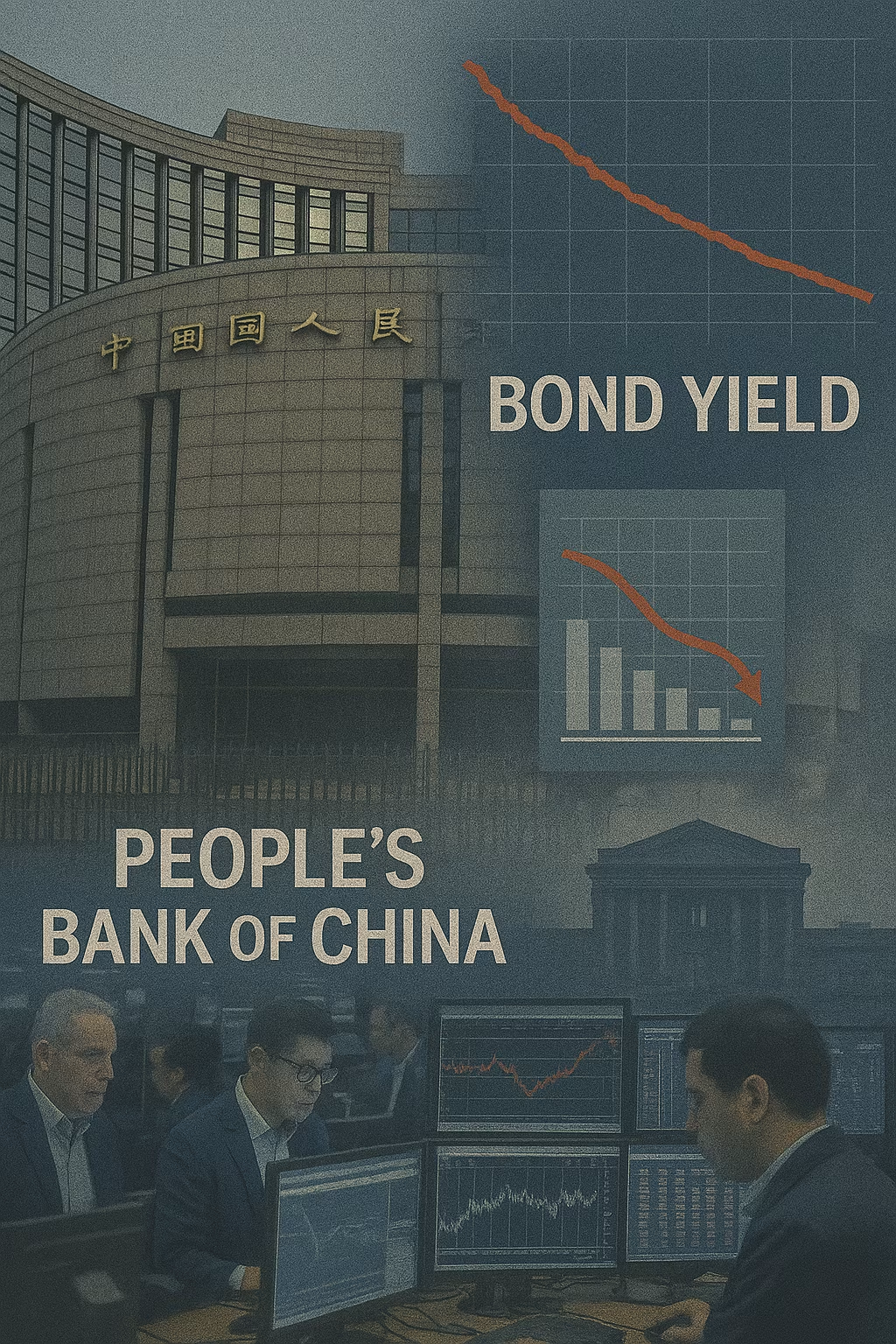China’s financial markets are under heightened scrutiny as authorities step in with stronger liquidity measures to stabilize investor confidence. The People’s Bank of China (PBOC) significantly increased short-term cash injections this week to ease funding pressures, a move that comes as a prolonged government bond selloff rattles markets and reignites concerns over the nation’s financial stability. While the central bank’s actions highlight its determination to restore calm, they also expose the fragility of market sentiment as investors navigate a complicated mix of slowing economic growth, fiscal stress, and global monetary tightening.
Bond Market Selloff Puts Pressure on Policymakers
China’s sovereign bond market, traditionally viewed as a safe haven for investors, has been facing sustained selling pressure in recent weeks. Yields on government securities have climbed as traders reassess their positions in response to rising fiscal deficits and uncertainty over the pace of policy support for the economy. The selloff, which has spread across different maturities, underscores the challenges facing policymakers in maintaining investor confidence while financing increased government spending.
For investors, the sudden rise in yields has eroded bond prices, triggering portfolio adjustments and amplifying volatility across broader financial markets. The pressure has been particularly acute in the medium- to long-dated securities, where concerns about China’s fiscal trajectory are most pronounced.
PBOC Steps In with Liquidity Support
In response, the PBOC announced a larger-than-expected injection of short-term liquidity through reverse repurchase agreements. By increasing the volume of seven-day and 14-day repos, the central bank aimed to ensure ample cash in the financial system and reduce the risk of funding strains. The move is intended not only to calm market nerves but also to prevent liquidity shortages that could spill into the broader economy.
Market participants interpreted the action as a clear signal that authorities are closely monitoring the bond selloff and are ready to act decisively to restore order. Still, the PBOC’s move reflects a delicate balancing act: too much liquidity could fuel speculative activity, while too little risks deepening investor anxiety and exacerbating the selloff.
Economic Context: Slowing Growth and Rising Fiscal Needs
The bond market turbulence comes at a time when China is grappling with slower economic growth and rising fiscal demands. The government has unveiled stimulus measures aimed at supporting domestic demand, including infrastructure spending and targeted tax breaks. However, these initiatives require substantial financing, prompting concerns about debt sustainability.
At the same time, structural challenges—such as a weakening property sector, subdued consumer confidence, and soft global demand for exports—are weighing heavily on economic performance. These pressures have fueled doubts about whether policy measures are sufficient to stabilize growth, contributing to the bearish sentiment in the bond market.
Investor Sentiment and Market Implications
The extended bond selloff has raised questions about how investors perceive the risk profile of Chinese government debt. While China’s debt levels remain manageable compared to some advanced economies, the lack of transparency in fiscal accounts and the rising role of local government financing vehicles (LGFVs) add layers of uncertainty.
Foreign investors, who have become increasingly active in China’s bond market through programs such as Bond Connect, have also shown signs of caution. The outflow of funds in recent weeks highlights the sensitivity of global investors to both domestic economic conditions and external factors like U.S. interest rate policy.
If the selloff persists, it could complicate the government’s efforts to fund its stimulus agenda, leading to higher borrowing costs and tighter financial conditions across the economy.
Global Context and Spillover Risks
China’s bond market turmoil is unfolding against the backdrop of global monetary tightening. With the U.S. Federal Reserve maintaining elevated interest rates to combat inflation, global capital flows have become increasingly volatile. Higher U.S. yields often draw funds away from emerging markets, putting additional pressure on Chinese assets.
At the same time, geopolitical tensions and concerns about supply chain resilience have already created a more cautious environment for global investors. The bond selloff in China adds another layer of risk that could reverberate across Asian markets, particularly if it leads to currency volatility or a sharp tightening of financial conditions.
Policy Options Moving Forward
The PBOC’s immediate response has focused on short-term liquidity support, but analysts believe additional measures may be required if bond market pressures persist. These could include adjustments to reserve requirement ratios (RRR) for banks, targeted support for financial institutions, or even direct bond purchases in extreme scenarios.
However, each policy tool comes with trade-offs. A broad loosening of monetary policy could undermine the yuan and exacerbate capital outflows, while insufficient intervention risks further erosion of investor confidence. The challenge for Chinese policymakers is to strike a balance that stabilizes markets without compromising longer-term financial stability.
Long-Term Structural Challenges
The ongoing turbulence in China’s bond market also highlights deeper structural issues. Local government debt, often hidden in off-balance-sheet entities, remains a persistent source of risk. The reliance on borrowing to fund growth-oriented projects has created fiscal vulnerabilities that investors are increasingly factoring into their assessments.
Furthermore, demographic pressures, including an aging population and a shrinking labor force, are constraining China’s potential growth rate. Combined with the global shift toward supply chain diversification, these structural headwinds mean that China’s fiscal and monetary strategies will face growing challenges in the years ahead.
Conclusion: Testing Market Confidence
China’s decision to boost short-term cash injections demonstrates its commitment to stabilizing markets, but the move also underlines the fragility of investor sentiment. The prolonged bond selloff is not just a reflection of technical market dynamics; it is a signal that confidence in China’s fiscal and economic trajectory is being tested.
For now, the PBOC’s intervention has provided some relief, but the broader question remains whether policymakers can deliver a credible strategy that addresses both immediate market concerns and long-term structural vulnerabilities. As global financial conditions tighten and domestic economic challenges mount, China’s ability to manage these risks will be closely watched by investors around the world.





